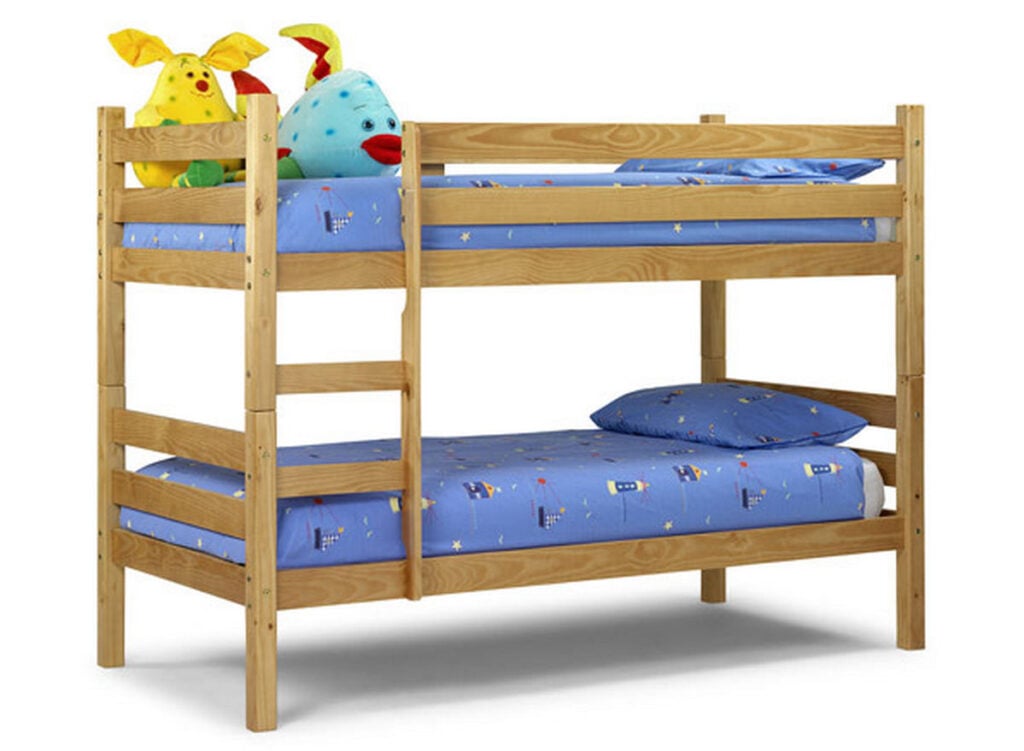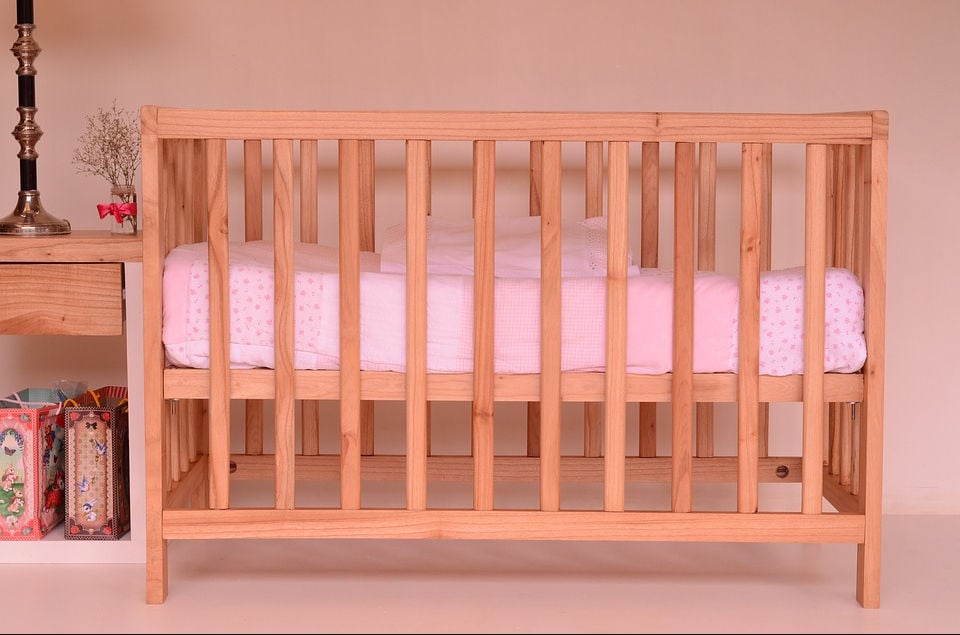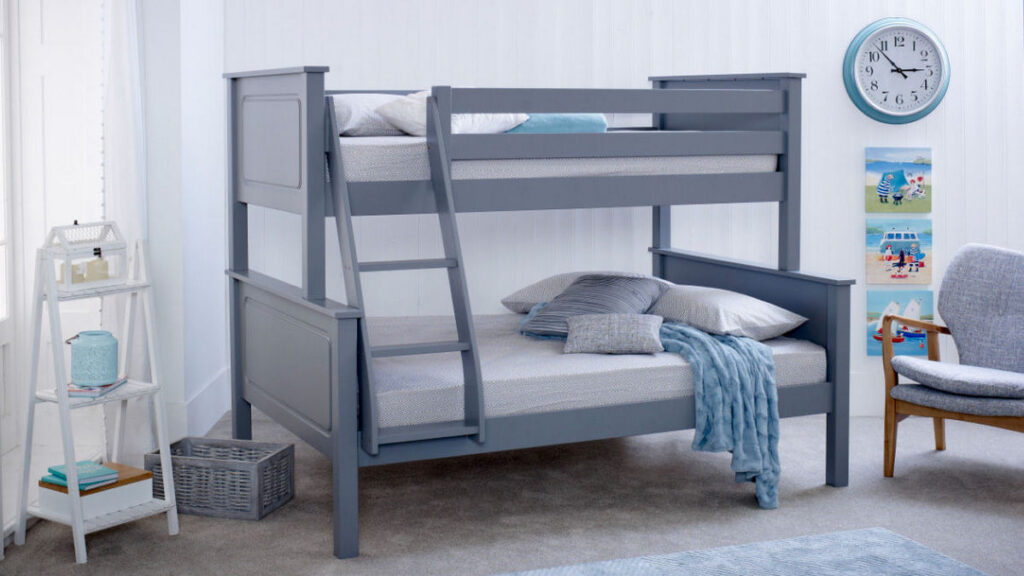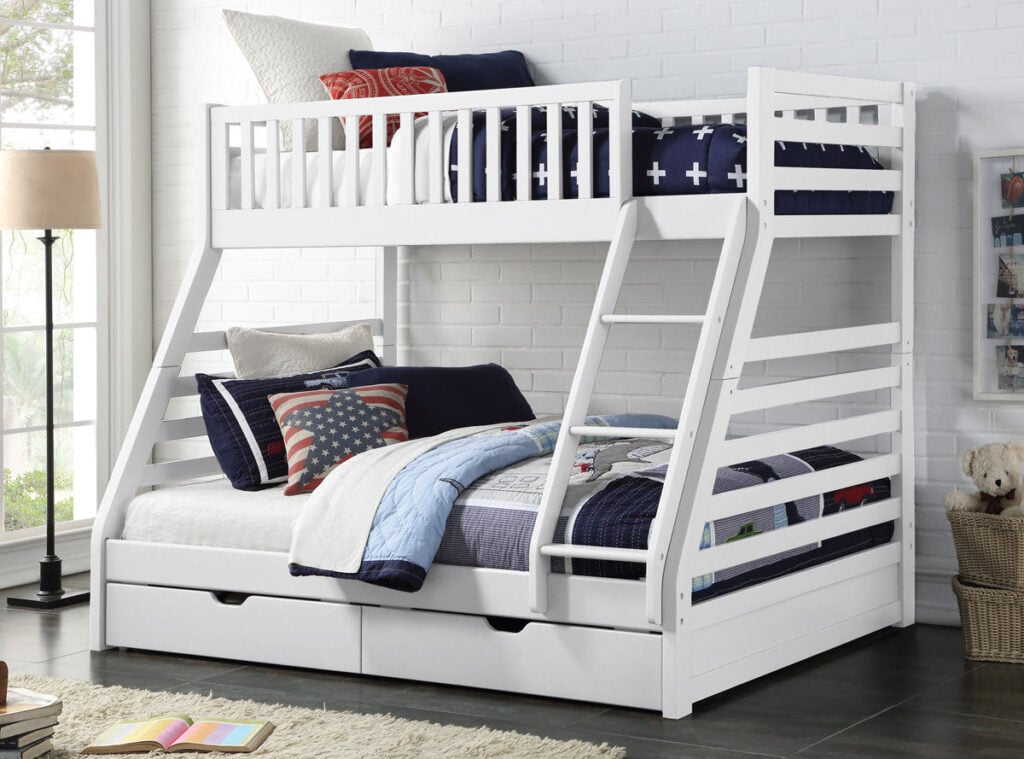Sleep Talk Blog, Bed and Mattress Guides
The Bedstar Guide to Bunk Bed Safety
Bunk bed safety
Bunk beds - when you’re a child, there’s a feeling of adventure about them, but you must use them safely, too. Respecting the purpose of the bunk beds and following a series of safety practices will minimise any potential danger.
If you’re buying bunk beds for your children, you should educate them on how to use them safely while implementing the right measures to prevent potential hazards. Our Bedstar Guide to Bunk Bed Safety is here to help you do this.
Understanding the dangers of bunk beds
Strangulation, suffocation, trapped limbs, and, most commonly, falls… there’s no denying the potential dangers of bunk beds. However, these things can often happen if you don’t assemble the bunk bed correctly or don’t follow safety procedures.
For instance, if you or your children misuse the bed, they can become dangerous. Treating the bed like a clothes horse can place the user(s) at risk of strangulation because they can become entwined in the clothes while they’re sleeping.
Not respecting weight limits can make the bunk bed dangerous. If you exceed the bed's weight limit but still climb into it, you’re placing yourself at risk of the bed collapsing (and of the resultant injuries).
Bunk beds are perfectly safe if you assemble the bed correctly and follow all the safety guidelines. Modern bunk bed manufacturers take safety very seriously and make every effort to ensure their beds are safe.

At what age are bunk beds safe?
Although no set age defines a bunk bed's safety, the general recommendation is that no child under 6 should sleep on the top bunk of a bunk bed. If a parent lets a child younger than that sleep on the top bunk, believing the child is old enough and aware of safety, they do so at their discretion. However, we certainly don’t advise this, and some organisations would recommend not letting anyone under the age of 9 years old sleep on the top bunk.
Can toddlers sleep in bunk beds?
The basic answer is ‘No.’ You might be thinking of buying a bunk bed if you have a second child on the way, but it would be a mistake to place a baby or a toddler in a bunk bed. A baby should only sleep in a cot.
It would help if you only let a child sleep in a bunk bed at the age you’d allow them to sleep in a normal bed. Even then, they may not fully understand the importance of safety rules, so think carefully before proceeding. As mentioned above, allowing a child under 6 years old to sleep on the top bunk is not advisable. No matter how much they plead with you, please don’t give in to them. It’s for their safety, remember.

Are bunk beds safe for adults?
The big kid in you might want to climb into a bunk bed. Think twice before you do so. Conventionally, bunk beds are for children, not adults, although the securest designs may handle the weight of an adult. Check the specifications for any weight limits. When assembling the bed, read the assembly instructions, offering further guidance on how to use the bunk beds safely.
Note that younger adults could become more prone to injury from a bunk bed. This is because of their increased size and weight as they age, which may start exceeding the bed's limits. Although a bunk bed may be suitable when young, it may stop meeting requirements as they age.
What’s the weight limit on bunk beds?
Different manufacturers may make their beds to different specifications, but you should always check whether the bed you wish to buy has a weight limit.
The general recommendation is that the top bunk is for lighter users, and anyone who weighs more than 175 lbs (79 kilos) should refrain from sleeping on one. Regarding the bottom bunk, manufacturers may again have different specifications, but, in general, if you weigh more than 200 lbs (90 kilos), you should find somewhere else to sleep.
Some beds may hold more, but remember that bunk beds are built with children in mind. If you have any doubts about the weight limits, check the specifications with the retailer.

What is the standard height of a bunk bed?
It’s not just when your kids are laying on the bed that you need to consider their safety; you’ve got to consider when they get out of bed, too. The average bunk bed height is 5.5 to 6 feet tall (167.6 to 182.8 cm), but you should measure the height of the room from the floor to the ceiling and ensure there will be at least 30 inches (76.2 cm) of space between the top bunk, from the top of the mattress, and the ceiling. Otherwise, the child could bang their head when they get up.
How much clearance do you need for a bunk bed?
Not many people ask this when they’re in a store, but it’s worth knowing about bunk bed clearance, i.e. the amount of space between the bottom bunk and the very bottom of the upper bunk. The average bunk bed clearance is 33 inches (84 cm), which would allow an adult to sit upright in the bottom bunk and not bash their head on the underside of the top one.
The bigger the clearance, the taller the bunk bed. A smaller clearance is better for smaller children because it means the bed will be shorter. They’ll be able to climb into it easier.
Bunk bed safety standards in the UK
All bunk beds must meet strict safety standards in the UK. One of the main ones is British Standard: EN747-1:2012+A1:2015. The standard requires that all beds must be solidly built and must have no sharp edges.
Bunk beds must also meet strict legal requirements under The Bunk Beds (Entrapment Hazards) (Safety) Regulations 1987. These concern themselves especially (but not exclusively) with guard rails, guard rail height and gaps in bunk bed structures. The purpose of the regulations is to stop any part of the child’s body from becoming stuck in between parts of the bed, such as guard rails, headboards and footboards.
According to the regulations, bunk beds should have guard rails on both sides, and there should be a gap of 11.8 inches (30 cm) to allow access to the bed. There should be no gaps of more than 2.95 inches (7.5 cm) concerning the sleeping surface, nor should there be any of less than 2.6 inches (6 cm) or more than 2.95 inches concerning other gaps in the structure of the bed.
Ladders can be detachable from the bed but must fit onto the bed firmly. The steps must be at least 1.18 inches wide (3 cm) and 7.78 inches (20 cm) apart.
Assembling a bunk bed safely
Some retailers will assemble the bunk bed for you, but often you have to put the bed together yourself. This isn’t as daunting as it might sound. Safety is as important to the manufacturers as it is to you, so they’ll provide clear instructions with the bed for you to follow. Here are a few tips:

Measure the room carefully
Decide where you want to place the bunk bed and measure all the room’s different dimensions, such as its height from floor to ceiling, width and length. Think about the position of its features, including fans, lights, windows and anything else that could be a danger, and how you will address these issues. Consider, too, any storage needs you have.
Make an inventory
Make an inventory of all the tools you’ll need to assemble the bed. Check that you have them all. Layout all the different parts of the bed and, again, make sure the manufacturers have provided all the necessary parts. It’s tempting to get stuck in and start assembling the bed, but there’s nothing more frustrating than realising there’s a screw missing when you’re already halfway through the task!
Assemble the bed somewhere no one will disturb you
You could assemble the bed in a garage or other large room, but then you have to transport it to its new location in the house, which isn’t always the best idea from a safety perspective. Instead, decide where you’re going to put the bed and start putting it together there if you have space. It would be unsafe to have the children running around the room while you assemble the bed, so lock the door so you can get on with the task without any distractions.
Follow the instructions carefully
The instructions guide you and make the bed as safe as possible, so follow them carefully. They may also provide you with extra safety tips. Take them on board. If they instruct you to start by making the bottom bunk first, which they’re likely to do, this is what you should do.

Fit guard rails on all sides
Guard rails are hugely important. It would be best if you had them on all sides of the bed. Don’t just have them on one side and rely on the wall to guard rail. A child can still get stuck between the bed and the wall, so make you have guard rails on all sides of the bed.
Guard rail height? We’ve discussed gaps; we’ve not discussed height. The guard rails should be at least 6.8 inches (16 cm) taller than the mattress so that the child can’t roll out of bed.
Buy a suitable mattress
The mattress has to be the right size for the bed. It can’t be too big or too small. Otherwise, the child could roll out of bed. If they’re on the top bunk, they may also end up catching the one in the bottom bunk as they fall. Buy a mattress in line with the size stated by the manufacturer.
Test the bed
Don’t just let your child sleep in the bed straight away once you’ve finished making it. Test that the bed is sturdy. Take a wedge block, too ― a 3.5 x 6.2-inch block that has a wedge-shaped tip and a hook on it ― and see if it fits through the gaps between the guard rail and the top of the mattress: it mustn’t be able to do this; if it does, the bed is unsafe, and there’s a chance the child will trap their head between the two.
How to use the bed safely

Although bed bunks have their risks, it’s possible to stop them from emerging and prevent accidents by taking simple safety precautions. This means setting rules to avoid misuse of the bed, implementing practical measures and adopting habits to make the bed safe. First of all...
Set some safety rules
Safety comes first, so don’t worry about being a killjoy. Set up some rules that the child(ren) should follow when using the bunk beds. These should include:
- No bouncing around on either bunk, particularly the top one.
- No climbing on the bed - the bed isn’t a climbing frame.
- No playing on the top bunk.
- No more than one person is allowed on the top bunk at any time.
You don’t have to frighten the living daylights out of your child(ren) as to what could happen, but you do have to let them know it’s for their safety. Make them understand the bed is for sleeping only (which it is).
Go over the rules regularly
You’ve laid down the rules. The child(ren) has understood them, and now you’ve implemented them. Great! Time goes by, however, and they may forget these rules. Maybe they remember them but are getting a little slack about respecting them or have started to bend them. It’s tempting. Go back over the rules with the children regularly, highlighting that they’re for their safety. Do this, too, when they have friends sleeping over.
Don’t let children hang clothes on the bed
The bed isn’t for hanging clothes on. Clothes hangers are for that, so don’t let your child(ren) hang clothes or anything else on the bunk bed. This is especially the case with belts or sports equipment, such as skipping ropes. A bunk bed user places themselves at the risk of strangulation if they do so.

Position the bed safely
Positioning the bed wrongly can transform it into a safety risk. Before you position the bed, and maybe even before you buy it, it’s best to take a look around the room and detect anything that could pose a danger. Blinds (especially the cords), windows, ceiling fans, lights and heaters are potential hazards when the bed is in the wrong position. Keep the bed away from these features to minimise the danger.
When positioning the bed, don’t rely on the wall to serve as a guard rail. A child can still become wedged between the bed and the wall, which, unfortunately, can have devastating consequences. The bed should have guard rails on all sides.
Encourage your child to use the ladders
Bunk beds will come with ladders or steps. It’s up to you to encourage your child(ren) to use them and never stand on a chair or other furniture item to get onto the top bunk. The ladders have been designed especially for the purpose, so they must always use them.
The child must be able to go up and down the ladders comfortably and confidently. This is crucial at night because they may wake up to go to the toilet. It’ll be dark, and they’ll be sleepy, so they must be able to climb up and down the ladder easily. You can make things even safer by placing a night light in the room so that they can see where they’re going. If not a night light, then ensure there’s a light switch within easy reach when you position the bed.
Remember to store away the ladder until nighttime. If the ladder is loose and small children are around, you could easily cause an accident, so put it away somewhere safe. Don’t let a small child climb the ladder. It’s asking for trouble.

Lay a carpet under the bunk bed
Perhaps you already have a carpet in the room to make it cosy, not to mention helping the children keep their feet warm on those cold winter days. That’s terrific. If not, you should lay a carpet under the bunk bed. The floor may be hard, but if there’s a carpet on it, the risk of head injuries, if anyone does have a fall, is lower.
Keep the bunk bed area clear
Kids are notorious for leaving their toys lying around. It’s best not to have them play around the bunk bed area at all if you can avoid it. If they’re playing in their room, though, then you should get them into the habit of putting their toys away, either in a toy box or other storage facility.

A final word on bunk bed safety
Safety is paramount. One thing you should always do is confirm whether the manufacturer or the retailer has recalled the bed you’re planning to buy. If they have at any point, whether before you buy the bed or once you’ve assembled it, the response is a no-brainer: you either don’t buy it or you don’t let your children continue sleeping on it, as applies.
Enjoying bunk beds and keeping them safe is a question of respecting their purpose and taking practical steps to prevent them from posing a danger. Understanding the dangers, following safety guidelines, and educating your children on how to use them safely can cancel out bunk beds' hazards so that the beds remain what they’re meant to be: a comfortable place to sleep.




